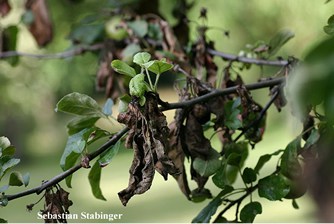 Description: Fire blight gets its name from the burnt appearance it leaves on affected blossoms and twigs. It is one of the most devastating and difficult-to-control diseases of many fruit trees including pear and apple. It also attacks roses and other ornamental plants such as crabapple, pyracantha, cotoneaster, hawthorn, photinia, quince, mountain ash, loquat and spirea. It is caused by bacteria which starts its attack on blossoms or flowers and moves up to the twigs and then branches.
Symptoms: Symptoms of fire blight first appear in early spring, when temperatures are above 60 degrees and the weather is rainy or humid. Infected flowers turn black and die. The disease moves down the branch, leaving blackened, curled twigs and giving the appearance of a shepherd’s hook. Leaves on affected branches wilt and blacken but remain on the tree, giving it a fire scorched appearance. Cankers (slightly sunken areas) appear on the branch and trunk. During wet weather translucent amber or reddish liquid containing masses of bacteria may be seen oozing out of plant parts.
Fire blight is easily spread in many different ways. Rain splashes the bacteria from one plant to another. Birds, insects and animals can transmit it. An infected plant can touch an uninfected plant and begin the process. Even gardeners can transmit the bacteria on infected gardening tools or when watering. (Tools can be sterilized in an alcohol or bleach solution.) The time of maximum risk of infection is late spring or early summer when the bacteria emerge from their dormant period and the oozing cankers are most pronounced. When pruning infected branches, never leave them on the ground. Either discard it in the trash or burn it or you will risk infecting surrounding bushes or trees.
Action: There is no cure for fire blight, which makes disease prevention extremely important. There are tolerant varieties, check with your nursery before purchasing new plants. ‘Bradford’ pear shows some resistance, but can become infected when conditions are favorable for disease development. Avoid excess nitrogen fertilization which results in excess succulent growth. Antibiotic treatments, coupled with soil therapy can suppress the disease. Keep your trees healthy to stop the spread.
Thank you for reviewing this information. Schneider Tree Care is committed to preserving and enhancing the quality of your property through tree care education and services. We employ professionally trained and certified arborists who are available to meet with you for a consultation at no charge.
If you have any questions or need additional information regarding the health of your trees, please contact us.
Description: Fire blight gets its name from the burnt appearance it leaves on affected blossoms and twigs. It is one of the most devastating and difficult-to-control diseases of many fruit trees including pear and apple. It also attacks roses and other ornamental plants such as crabapple, pyracantha, cotoneaster, hawthorn, photinia, quince, mountain ash, loquat and spirea. It is caused by bacteria which starts its attack on blossoms or flowers and moves up to the twigs and then branches.
Symptoms: Symptoms of fire blight first appear in early spring, when temperatures are above 60 degrees and the weather is rainy or humid. Infected flowers turn black and die. The disease moves down the branch, leaving blackened, curled twigs and giving the appearance of a shepherd’s hook. Leaves on affected branches wilt and blacken but remain on the tree, giving it a fire scorched appearance. Cankers (slightly sunken areas) appear on the branch and trunk. During wet weather translucent amber or reddish liquid containing masses of bacteria may be seen oozing out of plant parts.
Fire blight is easily spread in many different ways. Rain splashes the bacteria from one plant to another. Birds, insects and animals can transmit it. An infected plant can touch an uninfected plant and begin the process. Even gardeners can transmit the bacteria on infected gardening tools or when watering. (Tools can be sterilized in an alcohol or bleach solution.) The time of maximum risk of infection is late spring or early summer when the bacteria emerge from their dormant period and the oozing cankers are most pronounced. When pruning infected branches, never leave them on the ground. Either discard it in the trash or burn it or you will risk infecting surrounding bushes or trees.
Action: There is no cure for fire blight, which makes disease prevention extremely important. There are tolerant varieties, check with your nursery before purchasing new plants. ‘Bradford’ pear shows some resistance, but can become infected when conditions are favorable for disease development. Avoid excess nitrogen fertilization which results in excess succulent growth. Antibiotic treatments, coupled with soil therapy can suppress the disease. Keep your trees healthy to stop the spread.
Thank you for reviewing this information. Schneider Tree Care is committed to preserving and enhancing the quality of your property through tree care education and services. We employ professionally trained and certified arborists who are available to meet with you for a consultation at no charge.
If you have any questions or need additional information regarding the health of your trees, please contact us. 









